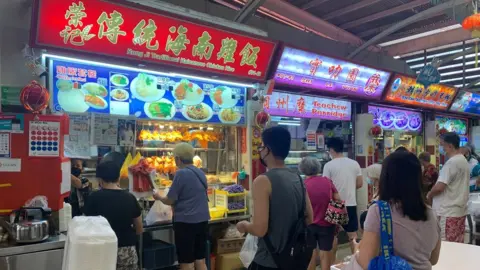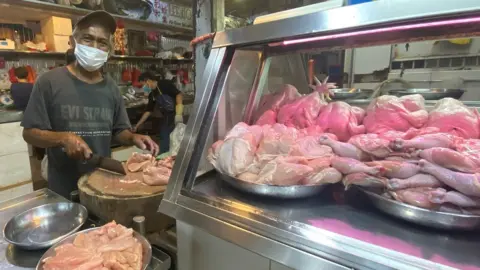Chicken rice: Why Singapore's much-loved dish is under threat
 Getty Images
Getty ImagesRachel Chong loves chicken rice so much she eats it three times a week.
"It is number one on my list. It's comfort food [and] it's easily accessible," she says. A standard order at Ah Keat Chicken Rice, a stall where she eats, costs S$4 ($2.90; £2.30).
For many Singaporeans, a plate of poached or roasted chicken on a bed of fragrant rice is a favourite meal. It's often referred to as the country's national dish. As one stallholder told the BBC: "I don't think Singapore cannot have chicken rice. It's like not having pizza in New York."
But this much-loved and affordable meal may soon become harder to get - and more expensive.
That's because its key ingredient - chicken - has been hit by export curbs.
As prices soar around the world, some Asian nations have banned or limited exports of key foods as they try to protect supplies at home. This week, Malaysia cut the number of chickens that could be exported.
This comes after India banned wheat exports and limited overseas sales of sugar, while Indonesia blocked exports of palm oil in a bid to rein in domestic cooking oil prices.
The moves have raised concerns in countries that rely on food imports that the cost of essential items will continue to rise. For Singapore, which imports more than 90% of its food, the curbs are especially worrying. The island nation relies on Malaysia for a third of the chicken it consumes.
Unsurprisingly, news of the export curb spurred queues at chicken rice stalls, which are found at almost every food court and hawker centre in Singapore.
"This time it is chicken, next time it may be something else. We have to be prepared for this," Singapore's Prime Minister Lee Hsien Loong said.
The birds used in chicken rice are usually exported live from Malaysia to Singapore where they are slaughtered, cooked and served.
This has no longer been possible since Malaysia blocked chicken exports, and its government said the ban would stay in place "until domestic prices and production stabilise".

Lim Wei Keat, the owner of Ah Keat Chicken Rice, said he was not keen to raise prices even though his Malaysian chicken supplier started charging him around 20% more this year, as the war in Ukraine drove up costs of fuel and corn feed.
"We don't want to increase the price of our chicken rice because it might drive away customers," Mr Lim said. "What we are expecting is maybe we can absorb the price for about a month. Worse come to worse, we have to actually start increasing prices by 50 cents per plate."
But he also worries that he may not be able to get enough chicken in the days ahead.
To make up the shortfall, he said he may have to use frozen meat, which may not be appetising to his customers.
"The perception of frozen is... there is the freezer smell or the texture is different," Mr Lim said. "But honestly I've not seen a big difference. We eat the chickens in [fast food] restaurants and they taste pretty good."
Meat sellers however have fewer options. Hamid bin Buang has been selling chicken at one of the city's thriving wet markets for more than a decade.
He said his customers have been buying more of the meat in recent days but now he plans to shut his stall until Malaysia lifts its export ban - he is not sure when he can replenish his stocks.
"Everybody is worried now. Everybody is in difficulty when there is no chicken," he said.

Farm to table
When countries limit exports, the effects are felt throughout the supply chains of producers, retailers and customers, said Paul Teng, a professor at the S. Rajaratnam School of International Studies.
Some producers "worry about surviving, livelihoods and also about future contracts", Mr Teng said in a recent interview with the BBC's Asia Business Report.
"At the retail level, if you increase prices, you might send customers away," Mr Teng said.
He added that he expects inflation, which is the rate prices of food and other essentials rise, to continue due to the Ukraine war.
It is partly why chicken - the most consumed meat in countries like Singapore and the UK - is becoming more expensive.
Elsewhere in Asia, India has banned wheat exports and capped its sugar exports at 10 million tonnes.
The country is the world's largest sugar producer and ranks number two for global exports of the commodity.
As Ukraine's exports of wheat plunged after the start of the war and other major producers faced droughts and floods, commodity traders were expecting India to make up for part of the shortfall.
"The example set by India currently is very problematic and a lot of smaller economies are thinking if India does it, so should we," said David Laborde, a senior research fellow at the International Food Policy Research Institute in Washington DC.
Meanwhile, palm oil prices surged this year when Indonesia, the top producer of the ingredient used in everything from processed food to soap, stopped exports for three weeks to bring down local cooking oil prices.
Mr Laborde also warned about the severe impact of the export curbs on consumers, especially those on low incomes.
"While food is still around, it is more expensive and the poor are the first victims. In some cases, they even have to cut health or education expenditures," he said.
Over a plate of her favourite dish, Ms Chong said she hopes price increases will not keep her from eating chicken rice.
"If we are able to afford that, we should still support businesses like coffeeshops or restaurants. We shouldn't hold back because it went up by a few cents," she said.
